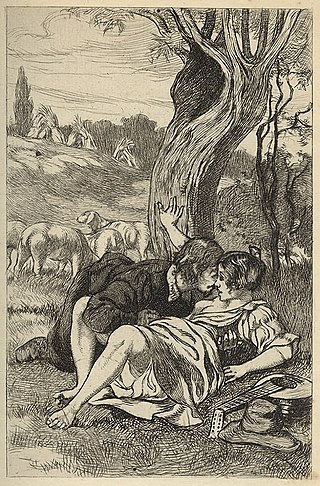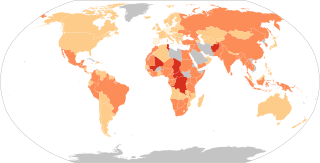Paraphilia is the experience of recurring or intense sexual arousal to atypical objects, situations, fantasies, behaviors, or individuals. It has also been defined as a sexual interest in anything other than a consenting human partner.

Foreplay is a set of emotionally and physically intimate acts between one or more people meant to create sexual arousal and desire for sexual activity. Although foreplay is typically understood as physical sexual activity, nonphysical activities, such as mental or verbal acts, may in some contexts be foreplay. This is typically the reason why foreplay tends to be an ambiguous term and means different things to different people. It can consist of various sexual practices such as kissing, sexual touching, removing clothes, oral sex, sexual games, and role playing.

Sexual roleplay is roleplay that has a strong erotic element. It may involve two or more people who act out roles in order to bring to life a sexual fantasy and may be a form of foreplay and be sexually arousing. Many people regard sexual roleplay as a means of overcoming sexual inhibitions. It may take place in the real world, or via an internet forum, chat-room, video-game, or email—allowing for physically or virtually impossible erotic interests to be enacted.
Sexual assault is an act in which one intentionally sexually touches another person without that person's consent, or coerces or physically forces a person to engage in a sexual act against their will. It is a form of sexual violence that includes child sexual abuse, groping, rape, drug facilitated sexual assault, and the torture of the person in a sexual manner.
Sexual desire is an emotion and motivational state characterized by an interest in sexual objects or activities, or by a drive to seek out sexual objects or to engage in sexual activities. It is an aspect of sexuality, which varies significantly from one person to another and also fluctuates depending on circumstances.

A sexual fantasy or erotic fantasy is an autoerotic mental image or pattern of thought that stirs a person's sexuality and can create or enhance sexual arousal. A sexual fantasy can be created by the person's imagination or memory, and may be triggered autonomously or by external stimulation such as erotic literature or pornography, a physical object, or sexual attraction to another person. Anything that may give rise to a sexual arousal may also produce a sexual fantasy, and sexual arousal may in turn give rise to fantasies.

Sexual stimulation is any stimulus that leads to, enhances and maintains sexual arousal, and may lead to orgasm. Although sexual arousal may arise without physical stimulation, achieving orgasm usually requires it.

Erotic humiliation is consensual psychological humiliation performed in order to produce erotic excitement or sexual arousal. This can be for either the person(s) being humiliated and demeaned or the person(s) humiliating, or both. It is sometimes performed before spectators, including through pornography and webcam modeling. It may be part of BDSM and other sexual roleplay, or accompanied by the sexual stimulation of the genitals of one or both parties in the activity.
Date rape is a form of acquaintance rape and dating violence. The two phrases are often used interchangeably, but date rape specifically refers to a rape in which there has been some sort of romantic or potentially sexual relationship between the two parties. Acquaintance rape also includes rapes in which the victim and perpetrator have been in a non-romantic, non-sexual relationship, for example as co-workers or neighbors.
American-Canadian sexologist Ray Blanchard proposed a psychological typology of gender dysphoria, transsexualism, and fetishistic transvestism in a series of academic papers through the 1980s and 1990s. Building on the work of earlier researchers, including his colleague Kurt Freund, Blanchard categorized trans women into two groups: homosexual transsexuals who are attracted exclusively to men and are feminine in both behavior and appearance; and autogynephilic transsexuals who experience sexual arousal at the idea of having a female body (autogynephilia). Supporters argue that the typology explains differences between the two groups in childhood gender nonconformity, sexual orientation, history of fetishism, and age of transition.
Rape is a traumatic experience that affects the victim in a physical, psychological, and sociological way. Even though the effects and aftermath of rape differ among victims, individuals tend to suffer from similar issues found within these three categories. Long-term reactions may involve the development of coping mechanisms that will either benefit the victim, such as social support, or inhibit their recovery. Seeking support and professional resources may assist the victim in numerous ways.
Pedophilia is a psychiatric disorder in which an adult or older adolescent experiences a primary or exclusive sexual attraction to prepubescent children. Although girls typically begin the process of puberty at age 10 or 11, and boys at age 11 or 12, psychiatric diagnostic criteria for pedophilia extend the cut-off point for prepubescence to age 13.

Rape is a type of sexual assault involving sexual intercourse or other forms of sexual penetration carried out against a person without their consent. The act may be carried out by physical force, coercion, abuse of authority, or against a person who is incapable of giving valid consent, such as one who is unconscious, incapacitated, has an intellectual disability, or is below the legal age of consent. The term rape is sometimes used interchangeably with the term sexual assault.
There are many theories explaining the causes of sexual violence. These theories include military conquest, socioeconomics, anger, power, sadism, traits, ethical standards, laws, and evolutionary pressures that lend some explanation to the causes of sexual violence. Most of the research on the causes of sexual violence has only been done on male offenders and has been a target of criticism.

Human female sexuality encompasses a broad range of behaviors and processes, including female sexual identity and sexual behavior, the physiological, psychological, social, cultural, political, and spiritual or religious aspects of sexual activity. Various aspects and dimensions of female sexuality, as a part of human sexuality, have also been addressed by principles of ethics, morality, and theology. In almost any historical era and culture, the arts, including literary and visual arts, as well as popular culture, present a substantial portion of a given society's views on human sexuality, which includes both implicit (covert) and explicit (overt) aspects and manifestations of feminine sexuality and behavior.
Alcohol and sex deals with the effects of the consumption of alcohol on sexual behavior. The effects of alcohol are balanced between its suppressive effects on sexual physiology, which will decrease sexual activity, and its suppression of psychological inhibitions, which may increase the desire for sex.

Sexual arousal describes the physiological and psychological responses in preparation for sexual intercourse or when exposed to sexual stimuli. A number of physiological responses occur in the body and mind as preparation for sexual intercourse, and continue during intercourse. Male arousal will lead to an erection, and in female arousal the body's response is engorged sexual tissues such as nipples, vulva, clitoris, vaginal walls, and vaginal lubrication.
Pregnancy is a potential result of rape. It has been studied in the context of war, particularly as a tool for genocide, as well as in other unrelated contexts, such as rape by a stranger, statutory rape, incest, and underage pregnancy. The current scientific consensus is that rape is at least as likely to lead to pregnancy as consensual sexual intercourse, with some studies suggesting rape may actually result in higher rates of pregnancy than consensual intercourse.
Rape myths are prejudicial, stereotyped, and false beliefs about sexual assaults, rapists, and rape victims. They often serve to excuse sexual aggression, create hostility toward victims, and bias criminal prosecution.

Justin J. Lehmiller is an American social psychologist and author. He is a research fellow at the Kinsey Institute at Indiana University.







